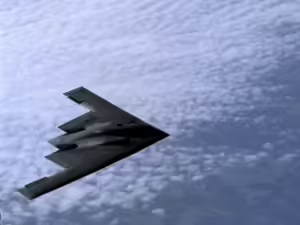The world’s biggest defence companies are in Paris this week for the world’s biggest land/air arms conference, Eurosatory.
And Eurosatory itself is bigger than ever this year, with 2,015 exhibitors hawking their wares to private contractors and governments, up from 1,726 in 2022.
Now, that’s all pretty intriguing to us, because the defence industry tends to be a barometer for lots of the broader issues we track closely. So let’s dive into five of the trends currently facing the sector:
Stay on top of your world from inside your inbox.
Subscribe for free today and receive way much more insights.
Trusted by 134,000+ subscribers
No spam. No noise. Unsubscribe any time.
- Governments are arming up
Global defence spending reached a record $2.4T last year and it’s showing no signs of slowing. Why? ‘Pax Americana’ is under strain and we’re back in a time of war (Europe, the Middle East) and rumours of war (East Asia).
So, spooked governments are not only arming up at conferences like Eurosatory, they’re also rebuilding their self-sufficiency, with export deals helping drive and sustain that process.
- Cash is flowing
Defence industry revenue is up, though that growth is now weighted towards Europe – this reflects fears of Russian aggression, and growing pressure to hit NATO’s defence spending targets. It also reflects some of the issues facing US companies, including inflation, supply chain, and labour-force retention issues.
Still, there are plenty of willing investors in the sector, which continues to perform strongly as an asset class: one industry index has been generating 15.9% annualised returns the last few years (double the benchmark).
- Companies are hiring
A new survey by the Financial Times suggests major European and US defence companies are now hiring at rates not seen since the Cold War. Ten of the largest companies are aiming to recruit 37,000 staff this year alone.
But they’re bumping up against some hard barriers: eg, university graduates often don’t have the right skills, and to the extent the ‘right’ grads are emerging, they’re often being snapped up by other sectors. Meanwhile…
- Opportunities are shifting
Relying on government contracts can bring stability, but it also brings scrutiny, including around your customers: there’s tension between guarding your secrets and affirming your values, while supporting your allies and blunting your rivals.
Against that backdrop, South Korea is carpe-ing the diem, doubling its arms exports to $14B since 2021 – it often sells to countries that can’t access or afford US kit, but who don’t want the strings that Russia or China might attach.
Meanwhile, more nimble tech startups are also disrupting the sector, showing new ways to deliver new capabilities on budget and on time – like the new Ghost Shark underwater drone that Anduril developed for Australia. And…
- Defence is becoming mainstream again
We’ve just had very two public examples drop: several indie artists withdrew from this year’s SXSW festival in Austin due to the US Army’s sponsorship of the event (the Army runs its main modernisation program from Austin).
But the festival organisers stood firm, noting the military’s role in developing key tech, and that “the Army’s sponsorship is part of our commitment to bring forward ideas that shape our world.”
Then last month, Europe’s largest ammunition manufacturer (Rheinmetall) announced it’s sponsoring the nearby German football team, Borussia Dortmund. The move drew backlash from some fans, who said it breached the club’s commitment to a society without violence.
But the club’s chair pushed back, arguing “we see every day how freedom must be defended in Europe. We should deal with this new normality.”
INTRIGUE’S TAKE
Back in 1993, defence industry executives scored an invite to a secret dinner at the Pentagon with the defence secretary, Les Aspin. He basically told the executives that the Cold War was over, defence spending would collapse, and their companies would need to merge to survive.
And… that’s exactly what happened: procurement spending almost halved in a decade, while the number of big defence firms dropped by 90% to just five.
But the world has now changed so much since 1993 (heck, since 2022!). The US has gone from having a defence industry that was too big, to one that’s stretched across multiple commitments, spanning today’s strange mix of WWI (trenches), WWII (air and armour), and WWIII (drones) tech.
So no, we haven’t heard of any more secret dinners to reshape the defence sector again, but the signs are there: the first full review of the US defence industrial base since Eisenhower; $100B in VC funding into defence in the past three years; the EU’s first-ever common defence industry strategy.
We could go on. And okay, we will: the Pentagon’s first-ever defence industrial strategy; the US sharing its super-secret nuclear propulsion tech with another country (Australia) for the first time since 1958. And so on.
So all this to say that fear not, dear Intriguer, but our world is changing.
Also worth noting:
- A French court has barred 74 Israeli companies from participating in this year’s Eurosatory expo, citing the humanitarian toll in Gaza. Russia and Belarus have also been excluded.
- A US poll from earlier this year suggests Americans are evenly split on whether their country spends too much, the right amount, or too little on defence. 44% of respondents also believe the US military isn’t strong enough.








